The latest Census figures paints a picture of just how much the demographic of the City of Delta has changed.
A recent Delta staff report to council highlighted some of those numbers including the city’s population growing by 6.1 per cent from 2016 to 2021, reaching 108,455. North Delta's population increased at a faster rate (8.5 per cent) than Ladner (3.7 per cent) and Tsawwassen (3.5 per cent).
North Delta now has 56 per cent of Delta's total population.
Meanwhile, Delta's median age declined slightly from 44.4 to 44 years from 2016 to 2021, but the number of people over the age of 65 increased by 3,115.
The percentage of people in Delta identifying themselves as a visible minority has been growing, from 36,300 (36 per cent) in 2016 to 48,625 (45.3 per cent) in 2021.
North Delta is home to 78 per cent of Delta's visible minority population, while the rest live in Ladner (13 per cent) and Tsawwassen (eight per cent).
South Asians made up the biggest segment at 27,990, up from 20,485 in the 2016 Census.
The next biggest segment of visible minorities in the 2021 Census were Chinese at 9,660, up from 7,685 in the 2016 Census. They were followed in the 2021 Census by Filipinos at 3,700, up from 2,655 in the previous Census.
Those listed as “not a visible minority” in Delta in 2021 stood at 58,645, down from 64,540 people in the 2016 Census. In Metro Vancouver, overall, the majority of residents now identify as a visible minority.
Meanwhile, Delta’s total immigrant population accounted for 33.1 per cent of the overall population in 2021, an increase from 31 per cent in 2016.
Recent immigrants (those who arrived between 2016 and 2021) made up 12.2 per cent of the total immigrant population. Most immigrants continue to come from India (46.8 per cent), but immigration from Syria saw the largest percentage increase from 1.2 per cent to 5.4 per cent.
Back in 2001, Delta’s population stood at just under 97,000. At that time, the “Canadian born” population of those surveyed was listed at 70,135, while the “foreign born” segment stood at 25,135.
By the 2021 Census, the “non-immigrant” population stood at 67,960, which was down over 1,000 people from 2016.
Statistics Canada notes “immigrant” refers to a person who is, or who has ever been, a landed immigrant or permanent resident. Immigrants who have obtained Canadian citizenship by naturalization are included in this group. In the 2021 Census of Population, immigrants include those who were admitted to Canada on or prior to May 11, 2021.
The latest Census numbers also indicate that there are 3,180 Indigenous people living in Delta, up from 2,710 in 2016.
A separate report on the city’s new Social Action Plan notes that more refugees are calling Delta home.
Between January and November 2022, 113 Government Assisted Refugees (GARS) settled in Delta, making Delta the third top city for GARs in B.C. Most came from Afghanistan and Syria, and 44 per cent are children under 18 years of age.
The Delta School District provides settlement services to immigrant families with children enrolled in schools, while additional newcomer and language instruction is offered at the George Mackie Library. However, there is no dedicated settlement agency in Delta and many immigrant residents are seeking settlement supports outside of Delta.
The Social Action Plan includes several actions to enhance settlement services for immigrants and refugees in Delta.
Mayor George Harvie during council’s discission on the latest community profile noted that the city’s parks and recreation services need to also diversify to meet the needs of the changing demographic, especially in North Delta. He asked staff to come back with a report.
Planning staff, meantime, will undertake growth projections, using Census and Metro Vancouver numbers, to see how to best serve Delta’s population as it grows and diversifies.



